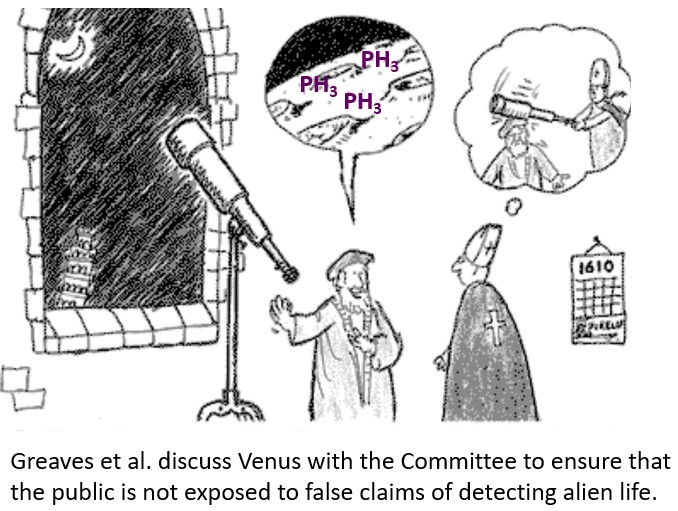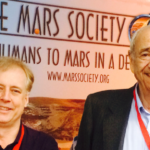Cite as: Benner, S. A. (2021) “NASA: The Gatekeeper of “Consensus Science”?”. Primordial Scoop, 2021, e1029. https://doi.org/10.52400/UZJZ9163
One year ago, Greaves et al. [1] reported the possible presence of phosphine (PH3) in the Venusian atmosphere. They suggested that this might indicate a Venusian biosphere.
NASA responded by organizing a workshop to come up with a “framework” that would define “standards” by which such claims should be evaluated. As best as I can tell, NASA was concerned that the public might tire of announcements of “discoveries” of alien life that later prove false. In a draft report just issued, NASA tells us that they see a need to protect the public from misinformation or “ambiguity”.
As full disclosure, I agreed to serve on this committee. I had already written a book on this very topic, including how burdens of proof might be managed in fields where hypothesis-based research is difficult [2]. But after I understood the goal of the workshop, I withdrew. In my view, committees that seek to institutionalize “consensus” are anti-science. More on this in a moment.
With respect to Venusian phosphine, I do not know enough to give an opinion on the specifically claimed observation. In particular, I do not know whether the proposed phosphine signal is real, or an artifact of the data processing that Greaves et al. used to uncover it from the observational noise.
However, I did outline on these pages my view of the biological conclusions of Greaves et al. [3]. I objected, as I often do, to treating the observation of unexplained phenomena as evidence for living phenomena. This is “biology in the gaps” reasoning.
For those who want to pursue such reasoning, I often first seek to analyze how a potentially observed chemical process might contribute to Darwinian fitness in a particular environment. That analysis can generally be grounded in well-known thermodynamic parameters: how much energy might a life form get from this process. Only later do I worry about the chemical process itself.
As I wrote in January, in the standard model for the Venusian atmosphere, it is difficult to see how the ejection of PH3 as a waste product would confer fitness to a life form. Phosphine is too reduced, and the Venusian atmosphere is too oxidizing, for the ejection of PH3 to make much thermodynamic sense a a way for a life form to be fit. But …
And in that “but” lies the kernel of science. “Science is the belief in the ignorance of experts” [4]. An “anti-consensus” result forced me to revisit about what (I thought) I knew about the Venusian atmosphere.
Jan Špaček was also forced to think [5]. With funding from the Breakthrough Foundation and discussions with colleagues at MIT and elsewhere, Špaček decided to do some experimental work. He asked: What was the likely fate of organic molecules in the Venusian atmosphere? After all, carbonaceous meteorites deliver organics to Venus all of the time, just like they do to Earth.
Before the summer was out, Špaček had found a blind spot in the field of Venus planetary science [5].
The spot? Decades ago, perhaps because of a dispute between Carl Sagan and Immanuel Velikovsky, the community had arrived at the consensus that the Venusian atmosphere held no (significant) organic material.
That created a puzzle. Well-validated observations show that the Venusian atmosphere is colored in a way that, perhaps naively, looked like it contained organics.
But because the “consensus” excluded organics as possible sources of the color, the community came to call its origins a “mystery absorber”. A large literature has emerged to account for this “mystery” absorption with inorganic compounds, like sulfur oxides. Even though the spectra of sulfur oxides do not match the spectra of the Venusian clouds.
Jan was alerted to this issue as he thought about the report of Venusian phosphine. Between founding a biotech company to distribute COVID tests and developing the electrochemistry of alien genetic systems, he found some time to think “outside the box” about this color. Jan built a concept model from known, semi-speculative, and unknown chemistry that (first) accounted for the color, and (then) for many other observed Venusian atmospheric phenomena. Using … organic molecules.
Like all good models, Špaček’s model made testable hypotheses. Working with undergraduate Gage Owens, Jan discovered that formaldehyde, a simple compound with just one carbon atom, one oxygen atom, and two hydrogen atoms (HCHO), when placed in strong sulfuric acid reminiscent of the Venusian clouds, gave a quite similar color. Not life, but …?
I then volunteered to be Jan’s technician (my group says they have never seen me happier). We recovered some of this material early in the chemical evolution of HCHO, did spectroscopy on it, and measured its mass. It was an organic polymer. In Venus-like conditions, HCHO assembled itself into large molecules, evidently forming new C-C bonds, with a repeating unit of two carbon atoms, two hydrogen atoms, and one oxygen atom. A polymer that might, with modification, hold information. Not life, but …?
This is an example of method in science. Many discoveries occur after someone, often someone famous, makes a remarkable claim, often one that turns out to be wrong. This causes others to do … well … to do science.
But what about the public? Does not the public need “experts” to protect it from the “potentially false”, “ambiguous”, or “misleading” claims that signs of alien life might have been discovered on Venus? Should the community not get together to protect the public? If we do not, won’t we risk having the public come to believe something that is not true? Still worse, will this make the public sour on science in general?
To ask such questions in this way is to answer them: Of course not. Every day, the public hears claims about UFOs, obesity, or hair loss. Most are false. They may waste money on useless products to cure baldness, but it is their money and their health. Science and its reputation are not damaged.
On the contrary, the public reputation of science is surely damaged if the public learns that “experts” are protecting them from non-consensus science. Even NASA experts. Repeating Feynman, “Science is the belief in the ignorance of experts.” The literate public knows this.
And even if protecting the public as if they were children were our goal, a committee of experts simply could not do it. Every scientific advance before its time was seen to be misinformation by some, often some who are very famous. It is impossible to place in advance burdens of proof for future disputes around which the specifics are not known; we simply do not know enough to choose which disputes-in-advance to adjudicate. We do not know the unknown unknowns.
In my book [2], I illustrated the problem by asking how a scientist should respond to a claim that the structure of water was H3O, not H2O. To a committee of experts, that response might likely be: “The claim violates settled science. The public must be protected from such misinformation.”
As I remark in the book, that response would have caused us to miss every major advance of the post-Enlightenment Age.
The correct response? “How interesting. Water. H3O? Remarkable. Why do you think so?”
And then the useful response requires us to consider other propositions that depend on water being H2O, propositions that [we think] are “settled”. Which of these must be wrong if water actually were H3O? How well validated are they? We then assess which model for water bears the burden of proof going forward.
It is a fallacy of hubris to think that “experts” can construct a “framework” of standards that assign burdens of proof before the observations are made. Indeed, this is the value of observational science; it can observe phenomena outside of the consensus, unexpected, even by “experts”.
These are called “discoveries”. Discoveries are not scripted. When they are made, they must not be evaluated against existing standards of proof. Rather, they must force scientists to revisit standards of proof. And if you doubt this, consider the futility of attempting to assign burdens of proof and truth probabilities to propositions about dark matter, pulsars, and the Casimir effect, before any of these had been observed.
The Greaves et al. report about phosphine was a report about a discovery. It might be right. It might be wrong. But here in Florida, it has already served its purpose: To drive science.
And as for the public? Regardless of NASA’s good intentions, the contrast is a tad problematic. Members of the taxpaying public may never have heard of phosphine, or know the hue of the Venusian atmosphere, or appreciate thermodynamics. But they can see the difference between the reaction of NASA versus the reaction of a scientist like Jan to a non-consensus, perhaps wrong, report about phosphine on Venus.
NASA, worried that the public might be exposed to a claim of life detection that turns out to be false, responded by setting up a workshop to see that it could never happen again.
Jan responded by doing some science.
[1] Greaves, J. S., Richards, A., Bains, W., Rimmer, P. B., Sagawa, H., Clements, D. L., … & Hoge, J. (2021). Phosphine gas in the cloud decks of Venus. Nature Astronomy, 5(7), 655-664.
[2] Benner, S. A. (2009) The Life, the Universe and the Scientific Method. Gainesville FfAME Press, 312 pp
[3] Benner, S. A. (2021) Aristotle and the search for life on Venus. Primordial Scoop, 2021, e0126. https://doi.org/10.52400/TKLO5825
[4] Richard Feynman, The Pleasure of Finding Things Out: The Best Short Works of Richard
[5] Spacek, J. (2021). Organic Carbon Cycle in the Atmosphere of Venus. arXiv preprint arXiv:2108.02286.




Steve-
I put a comment on the NASA website and I will put one on yours.
In my new version of my list of minerals and meteorites associated with the Origin of Life,
I start with a copy of the original discovery by Schiaparelli of “canals” on Mars in Harpers Weekly
in 1877 (I got it from a rare book dealer). Next to it I have a small brass telescope showing the
type of By instrument used to make the discovery in 1877.
In 1977, after the VIKING project declared “no life found on Mars” there were no launches by
NASA for 20 years. But at the turn of the 21st century they resumed. We had given up trying
to find “large life” after Carl Sagan passed, and were now looking for “small life ” using totally
different instruments such as Microscopes (scanning tunneling), Spectroscopes (Raman), Cameras
(from orbit and close up from rovers), etc. I have small versions of these types of instruments
next to my latest version of my minerals to exhibit as targets for finding biosignatures. They
should be in the proximity of my minerals. By stealth my minerals are on Perseverance website.
When I discovered that NASA and especially JPL had put in charge of picking the drill areas
for Perseverance a type of scientist known as a Geologist and these people were choosing
non-astrobiology targets I wrote to the Planetary Science Department at NASA Headquarters
asking for them to save some of the sample containers for astrobiology-oriented samples.
I got a promise in writing (email) they would not overlook this type of target.
My next conference will be the NoRCEL OOL conference at the University of St. Andrews in
August of 2022. By then the Rosalind Franklin rover will be launched. By the time samples
are returned in 2031 I will be age 93.
The paper in Nature for which I am a co-author shows how an archaea can digest a sample of
the surface of Mars from four billion years ago and provide proof in pictures using giant
analytical machines that can’t be mounted on rovers as you have already commented on in a previous blog. You can see where I heading with the above train of thought. Discovery of Life
on Mars is always just one step ahead. Will the discovery be at the molecular level, the atomic
level, the quark level, etc?
Bob Bruner
ISSOL member
Denver, Colorado, USA